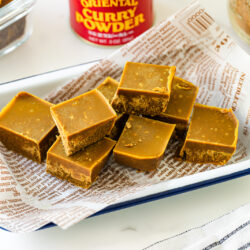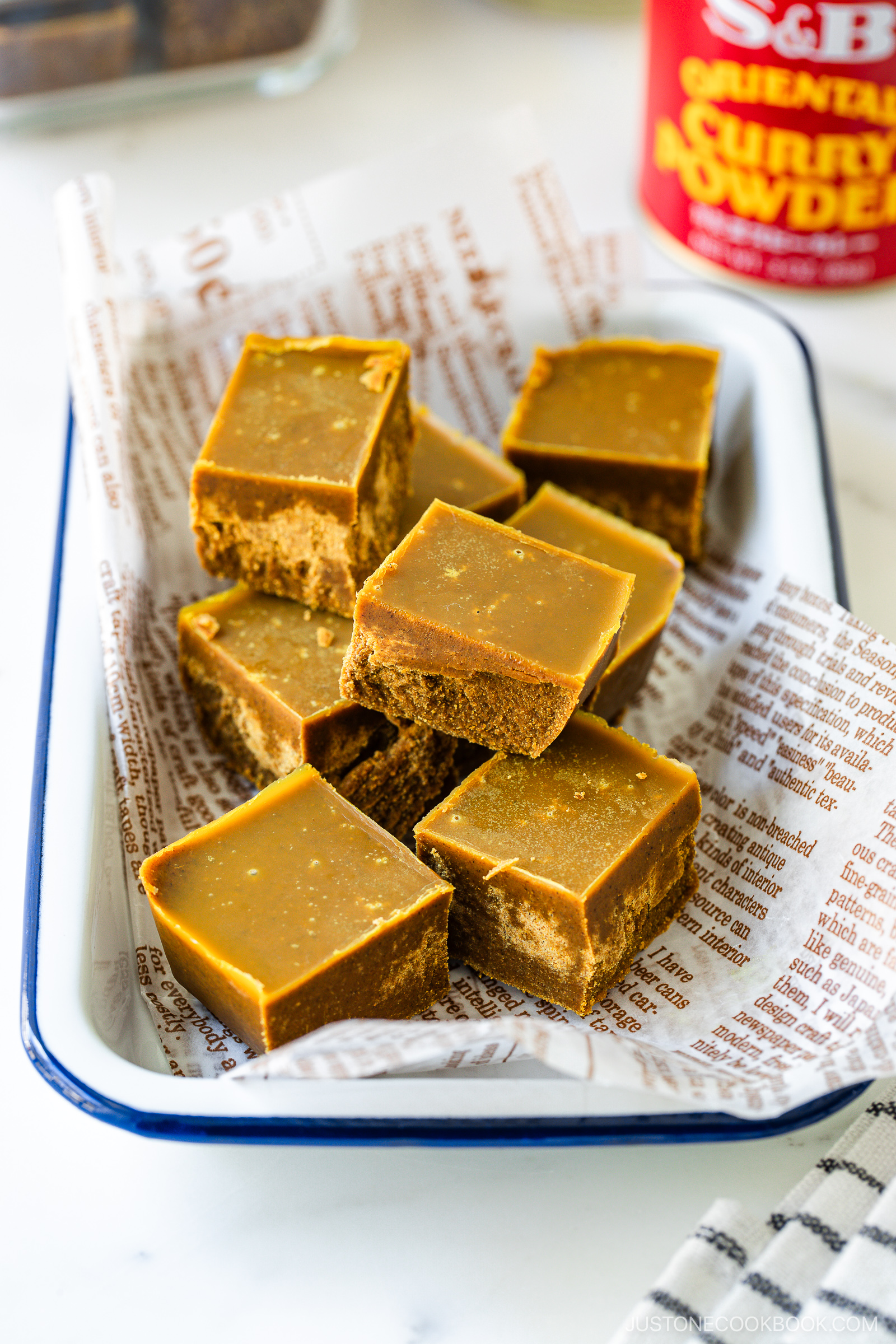
Japanese Curry Roux is the secret behind the cozy chicken curry rice many of us grew up eating in Japan. With this simple homemade recipe, you can make the blocks ahead of time, skip additives, and adjust the spice level to your liking. It’s your shortcut to rich, flavorful curry whenever you need a quick, satisfying meal.
If you’re looking for more ways to use curry roux, try my Japanese Chicken Curry, Curry Udon, and Japanese Beef Curry next!
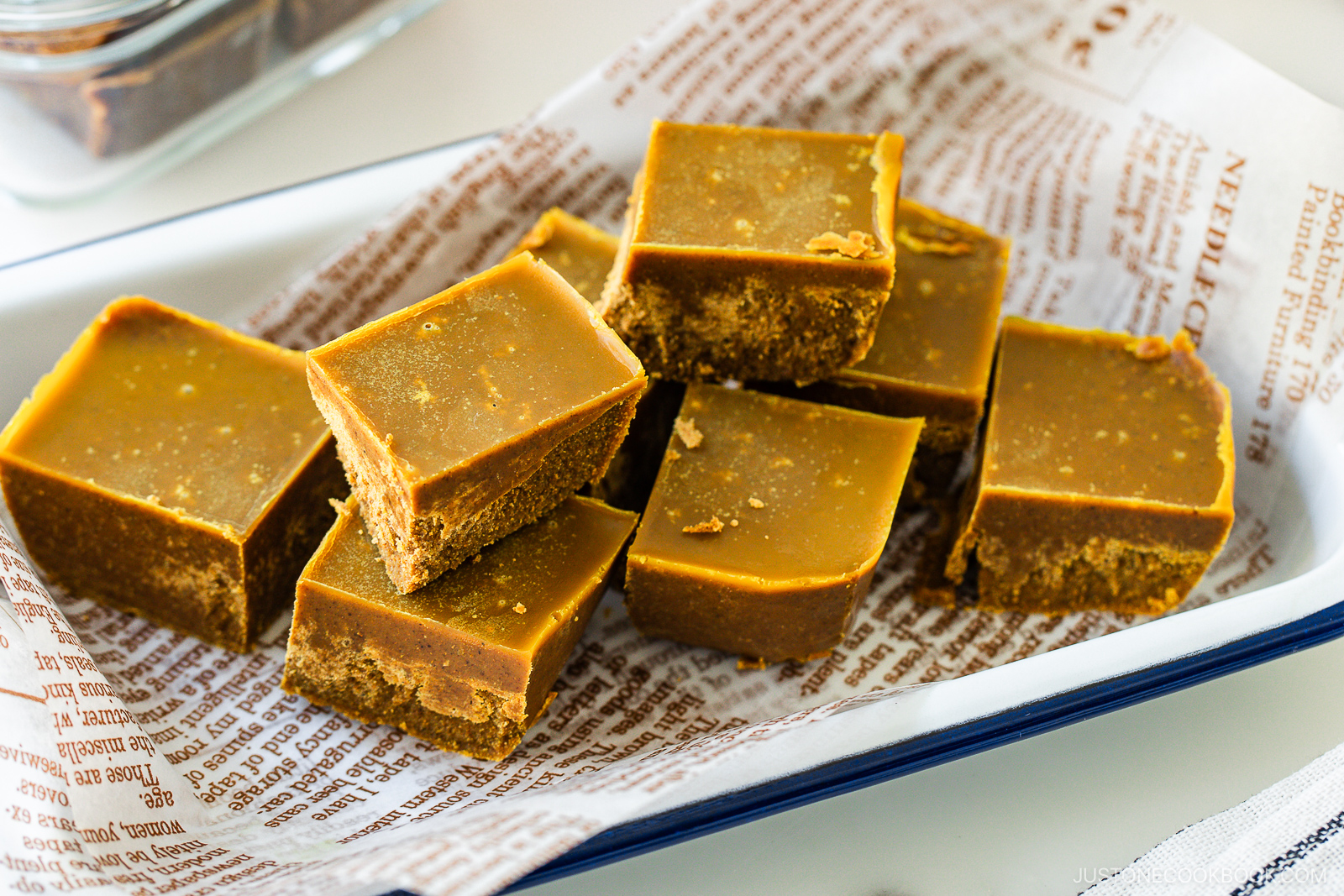
What is Japanese Curry Roux?
First sold in block form in 1956, Japanese Curry Roux (カレールー) is a blend of browned butter, flour, and warm spices pressed into a firm slab, which dissolves into broth and transforms it into curry sauce. Brands like S&B Golden Curry and Vermont Curry turned weeknight curry rice into a beloved household meal.
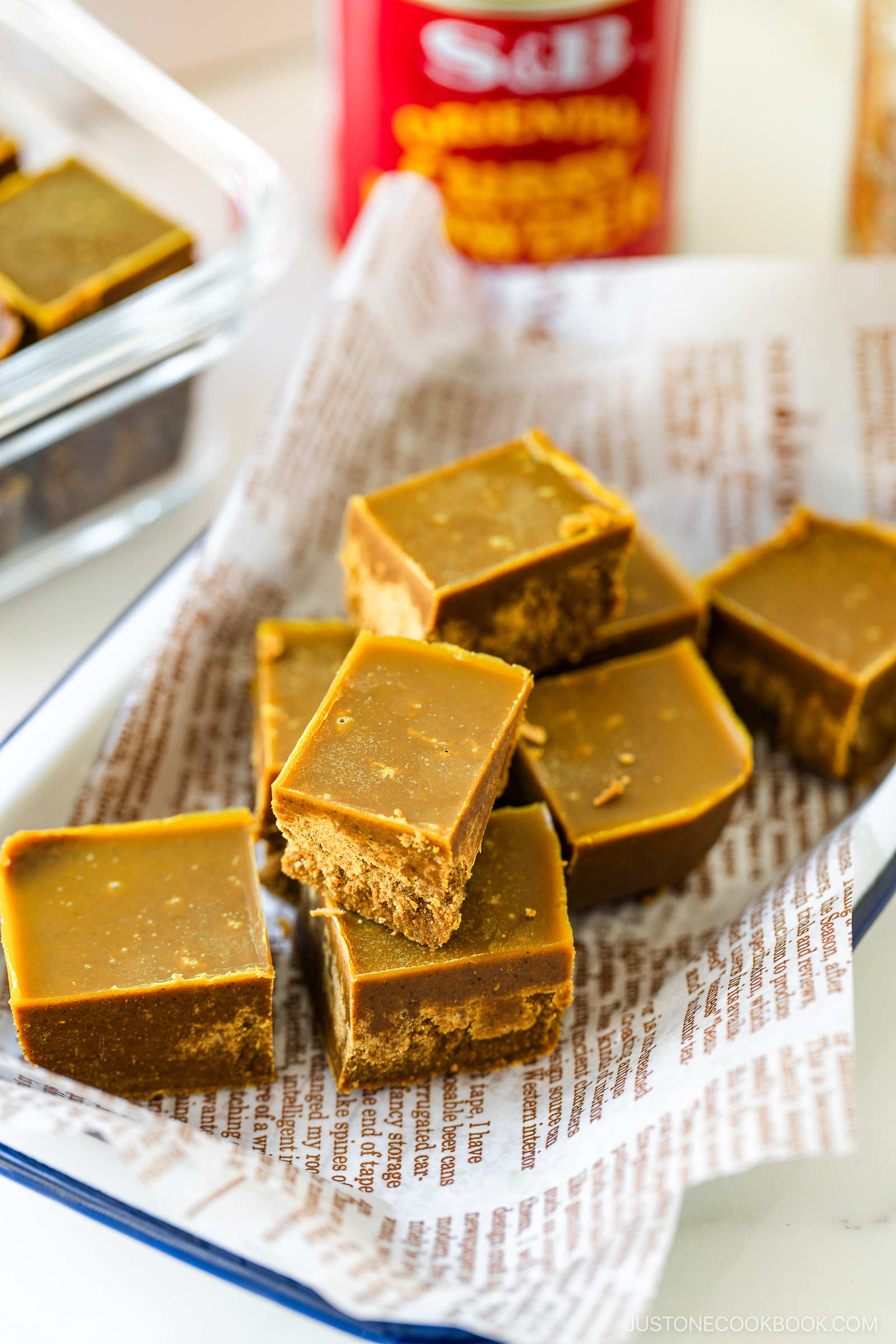
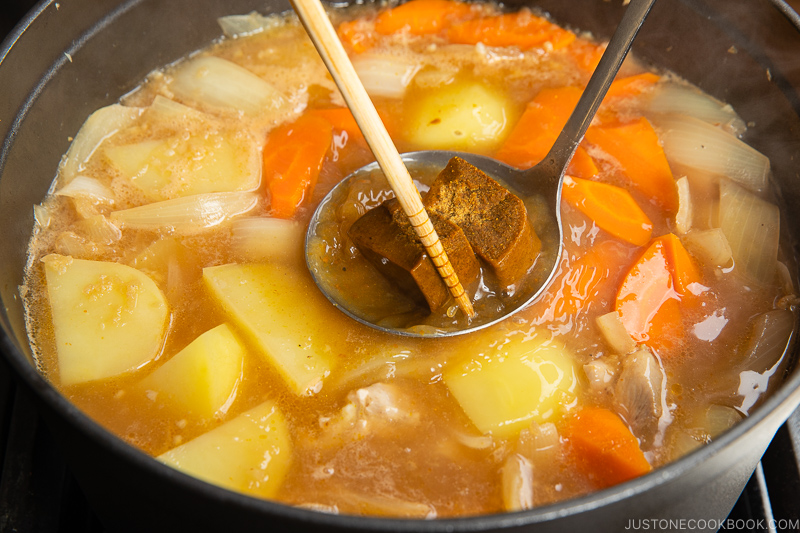
Ingredients for Japanese Curry Roux
- Unsalted butter
- All-purpose/plain flour
- S&B Japanese curry powder, or make it yourself with my recipe
- Garam masala
- Cayenne pepper – optional
Find the printable recipe with measurements below.
Jump to RecipeSubstitutions
- Unsalted butter: I like to add salt later when cooking my curry sauce, so I use unsalted butter for the roux. If you use salted butter, reduce the amount of salt you add to the curry.
- S&B Japanese curry powder: This mild, slightly sweet curry powder is my favorite brand. You can find it on Amazon or at Japanese markets. If you can’t get it, try my homemade Japanese Curry Powder recipe. Other curry powders work too, but they won’t give the same authentic Japanese flavor.
- Garam masala: A warming Indian spice mix with cardamom, cloves, cumin, coriander, turmeric, nutmeg, and black pepper. If you don’t have it, you can use the individual spices or add more curry powder instead.
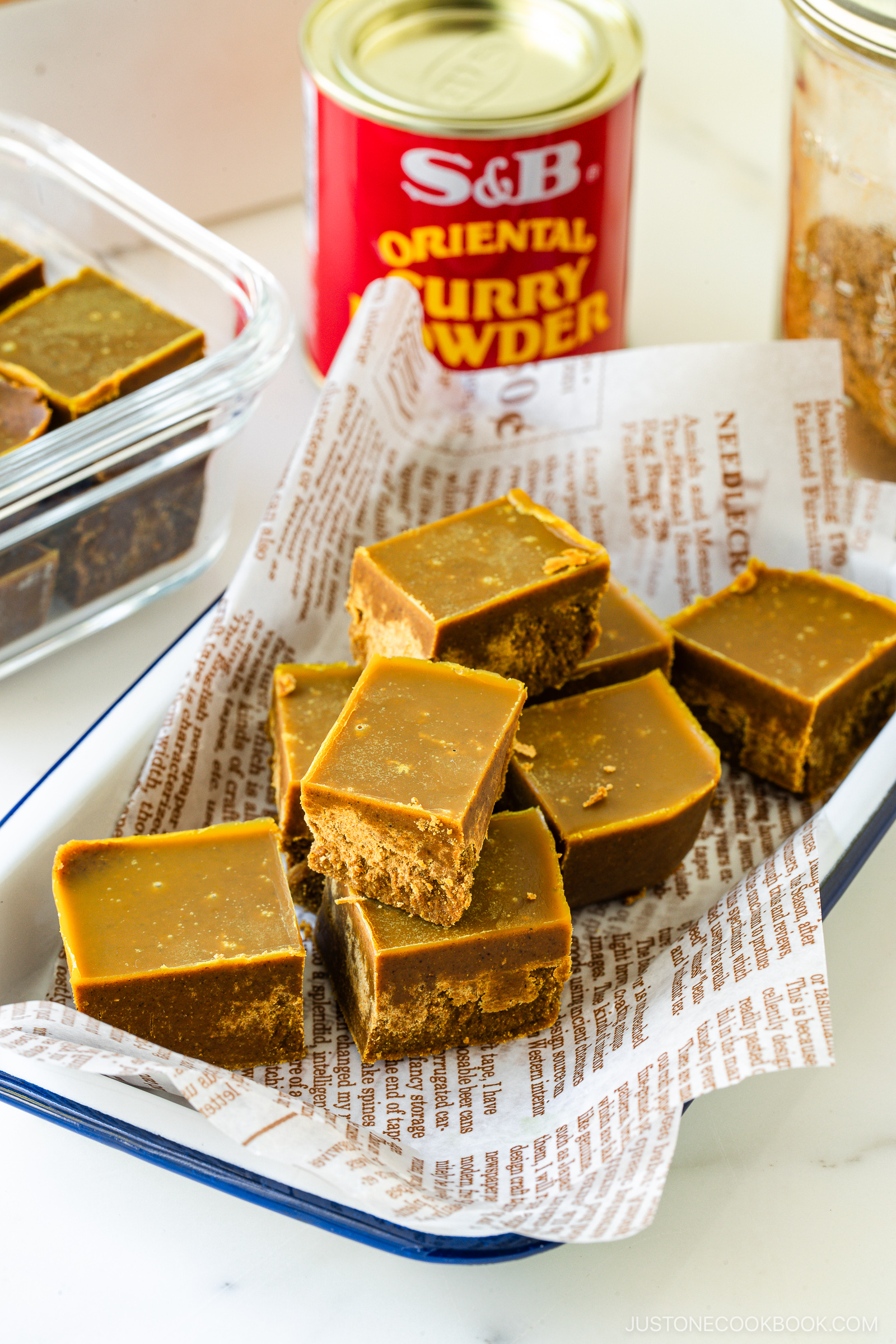
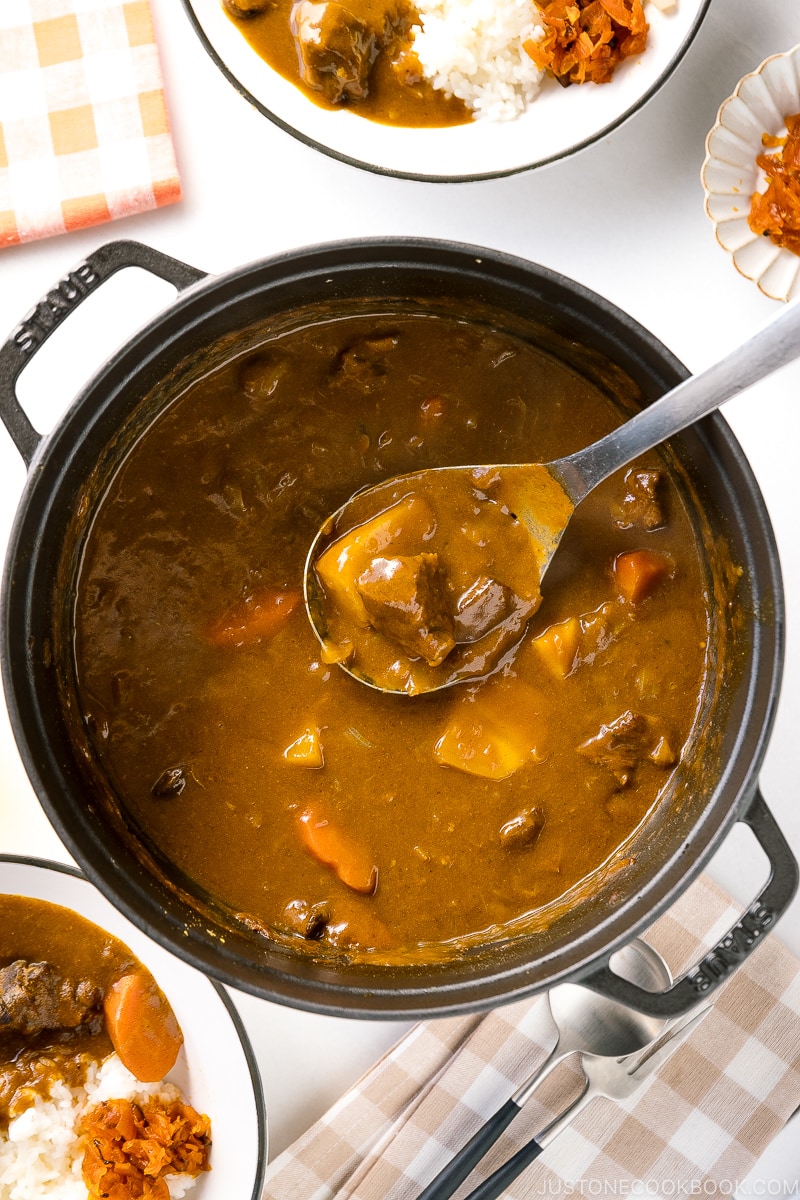
How to Make Japanese Curry Roux
Cook
- Build the base. Melt butter in a saucepan over medium heat and stir in flour with a wooden spoon to combine.
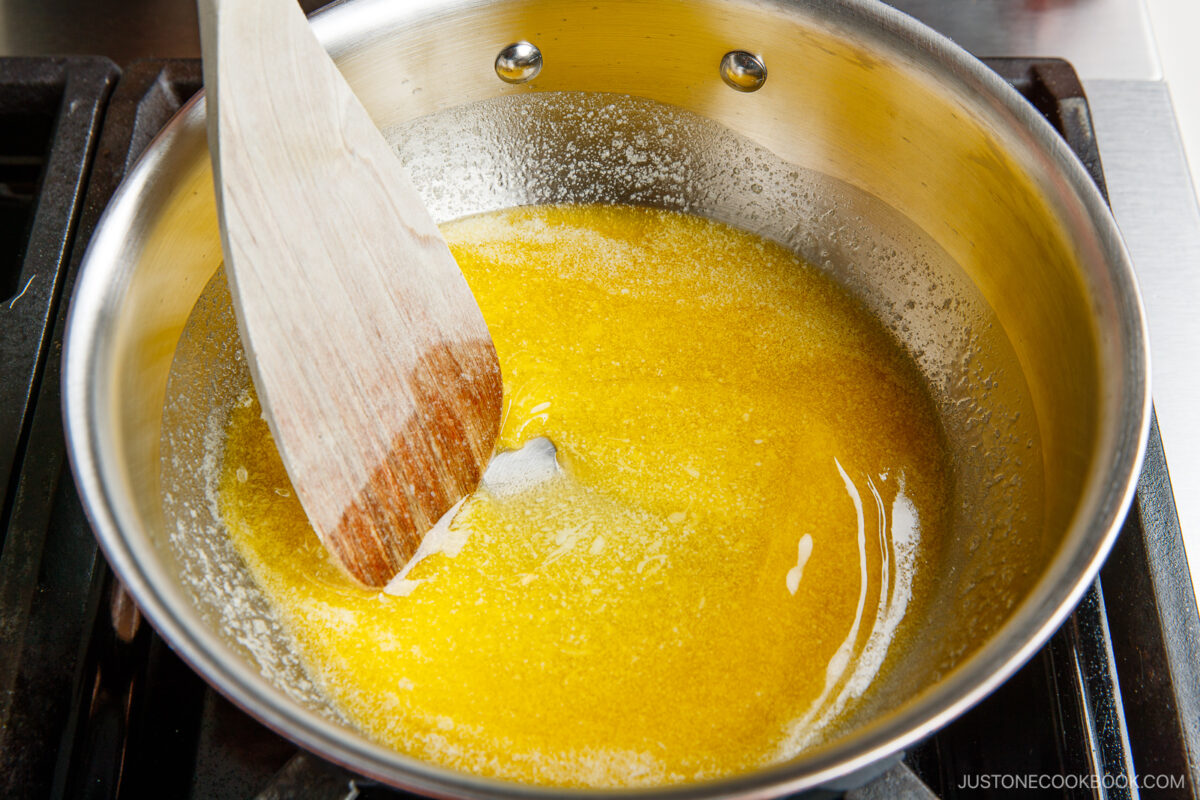
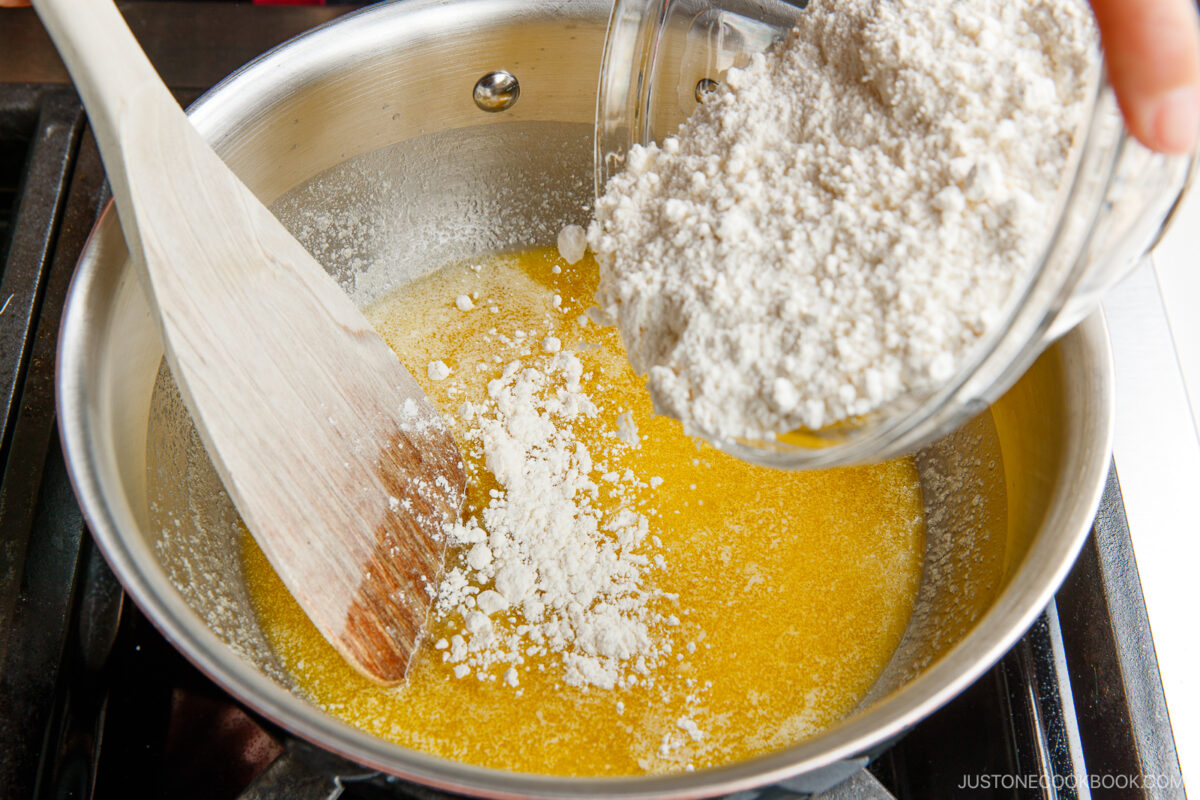
- Mix and cook it for 20–25 minutes until golden brown (see the next step to see the golden brown color).
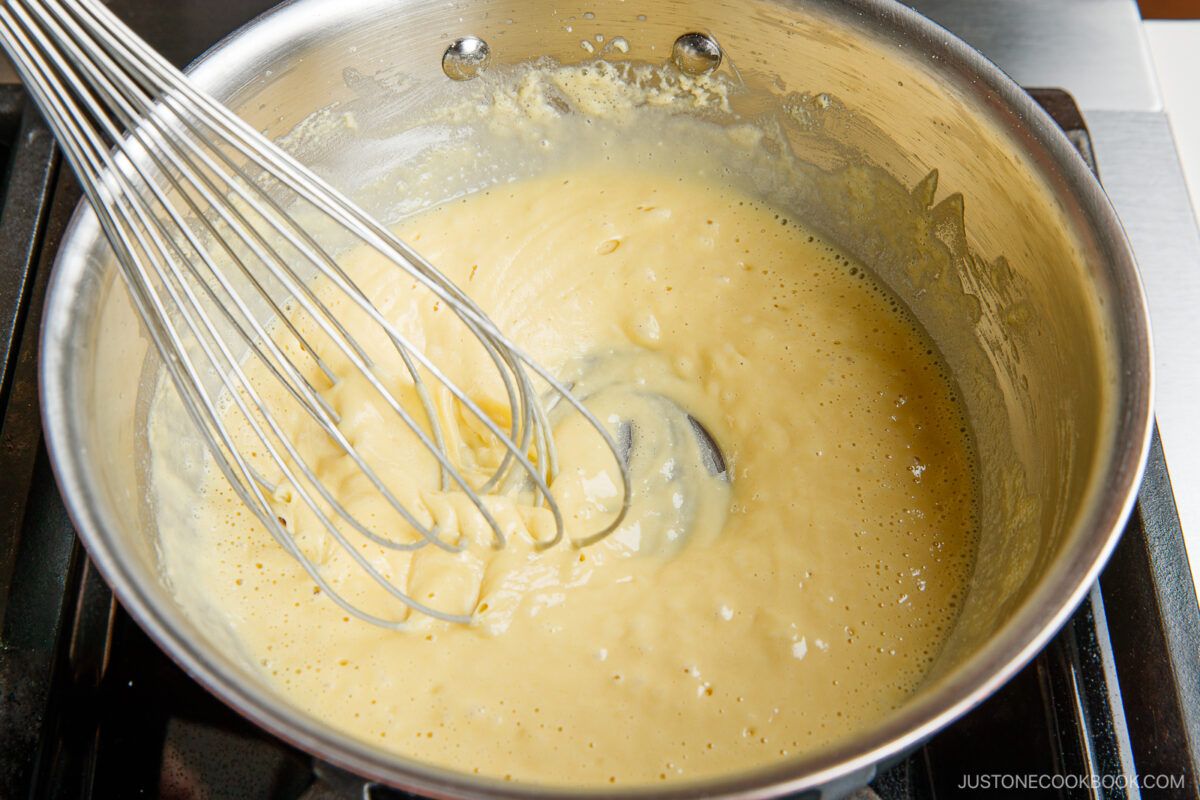
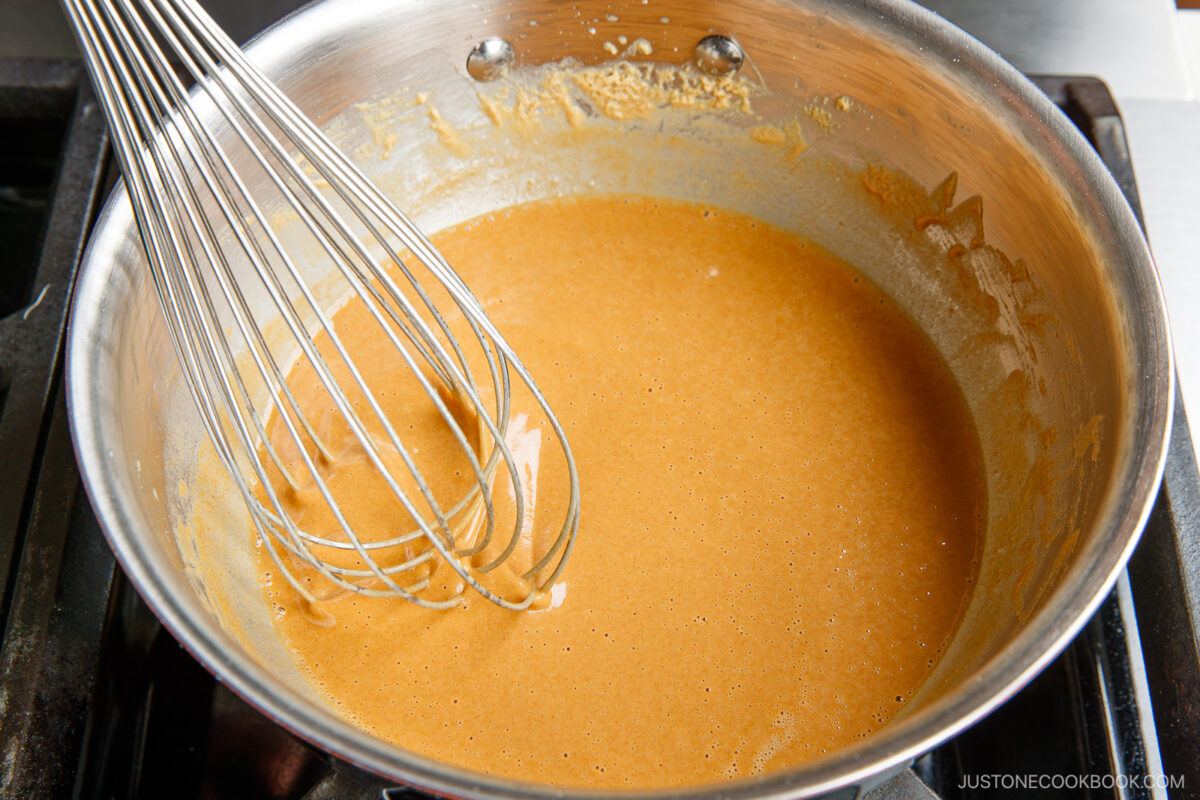
- Add the spices, then whisk and cook for 30 seconds.
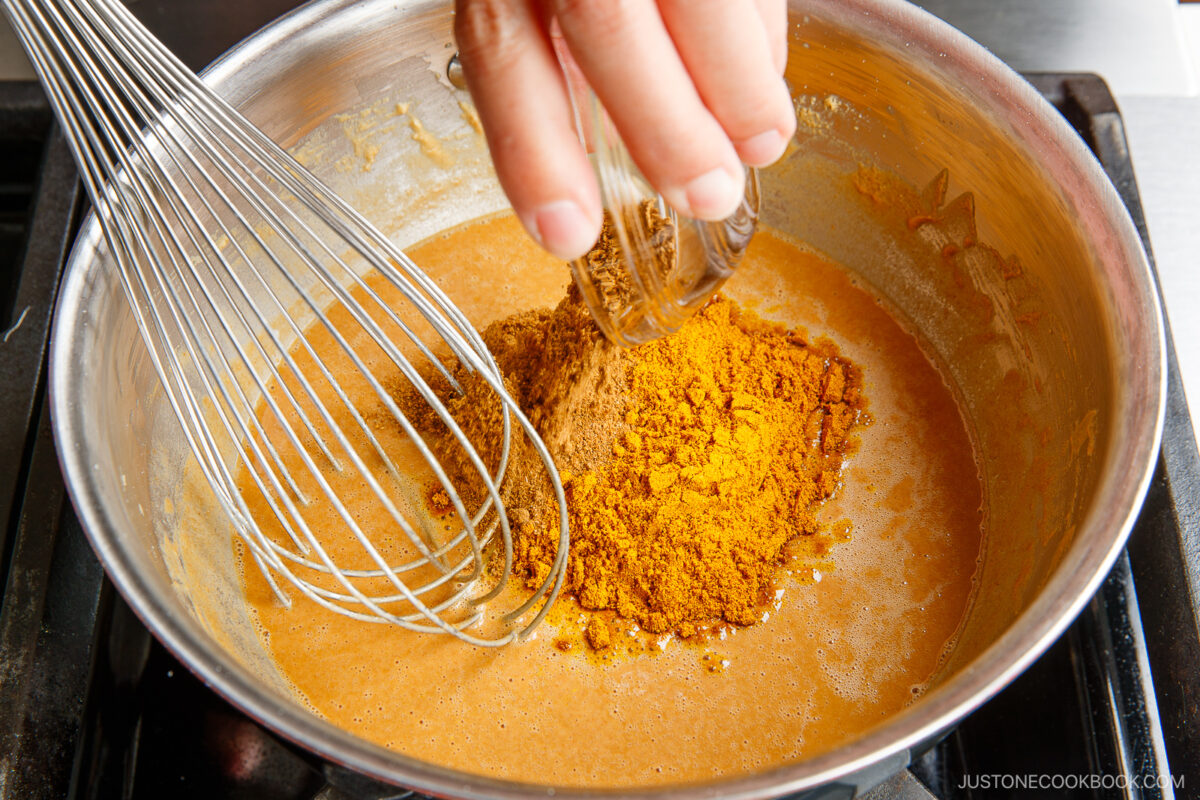
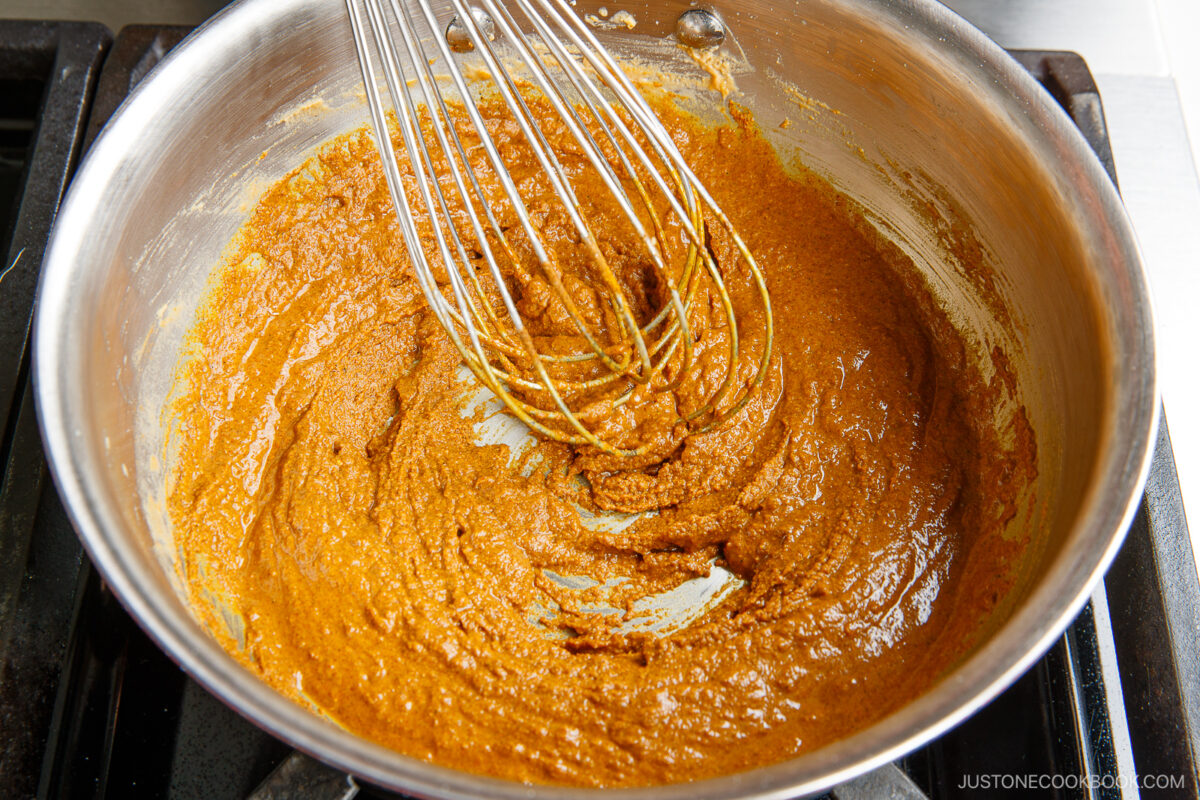
Assemble
- Mold the mixture in an airtight glass or metal container lined with parchment paper. Cool, then refrigerate overnight to solidify.
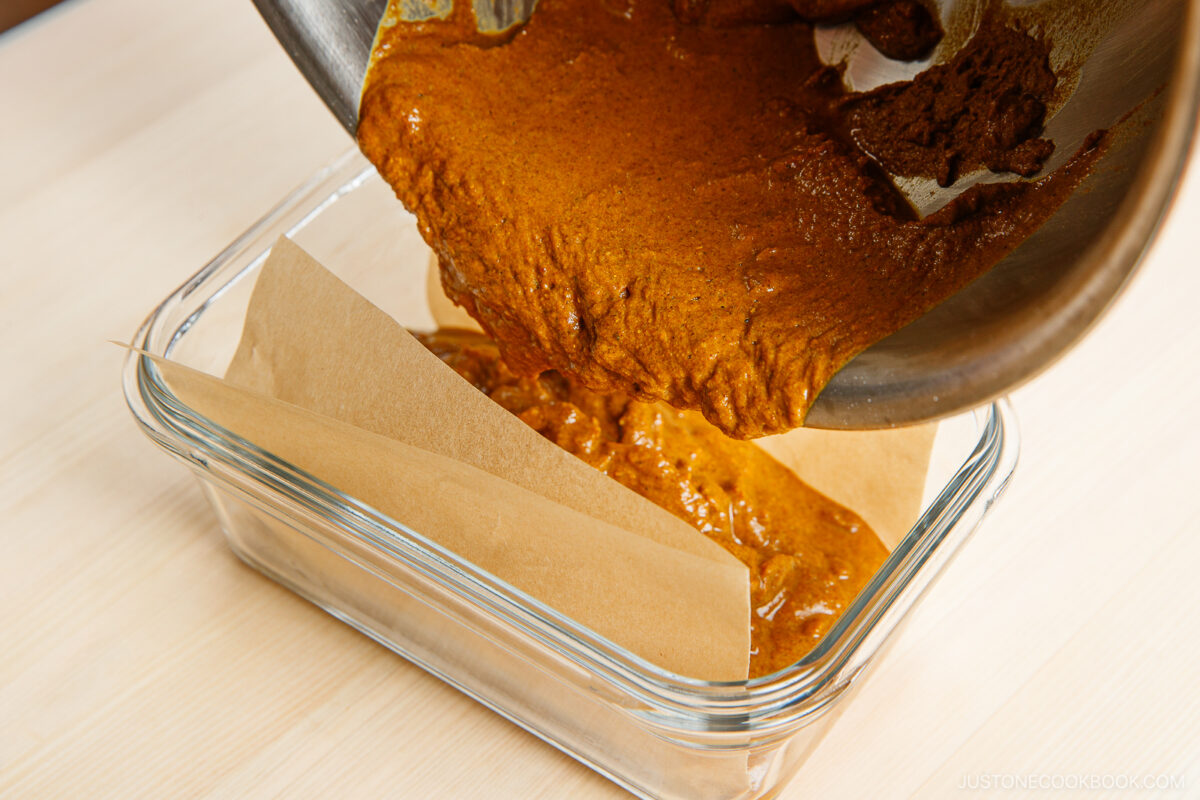
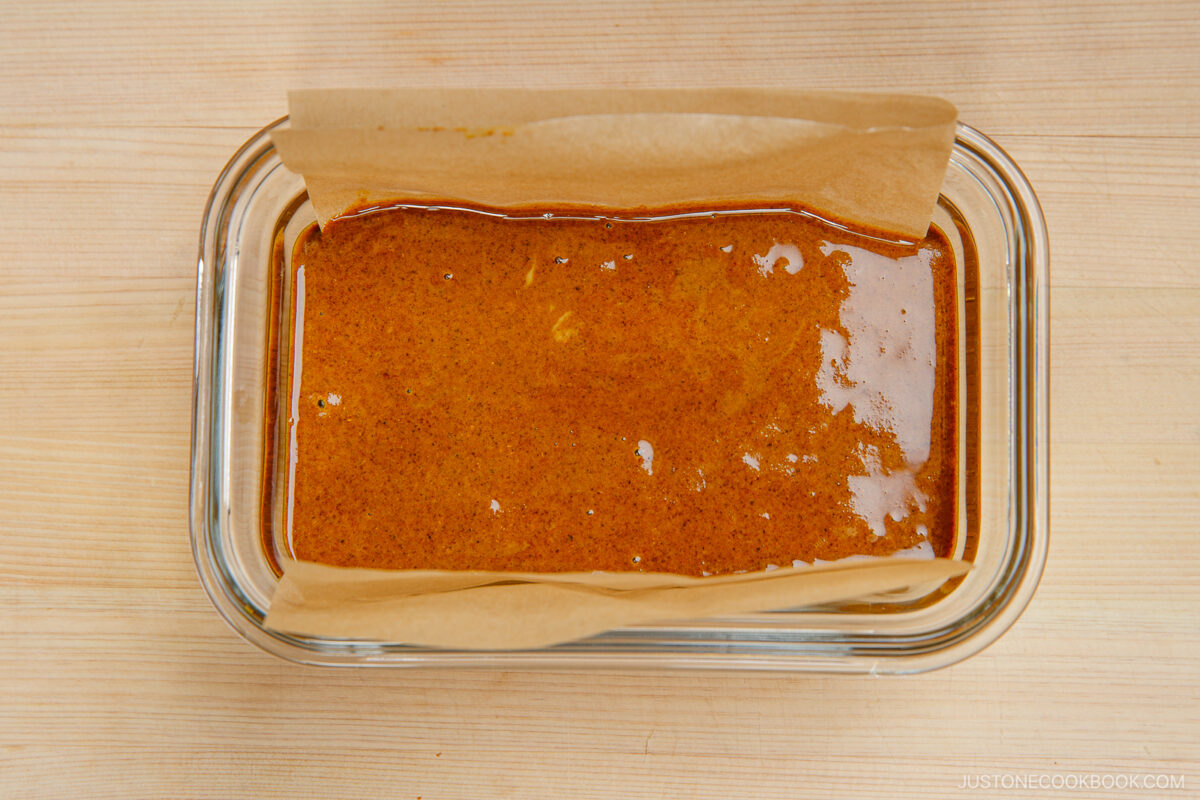
- Cut the firm roux into cubes the next day and store in a glass container until ready to use.
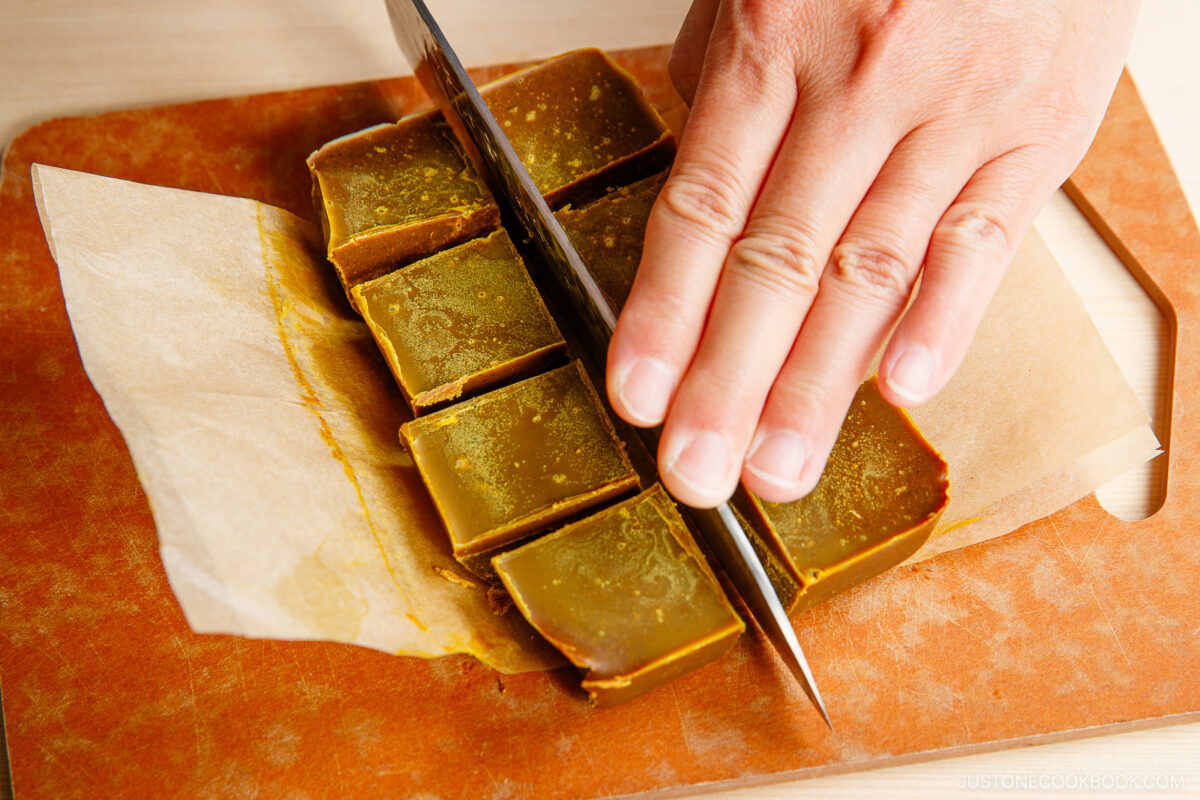
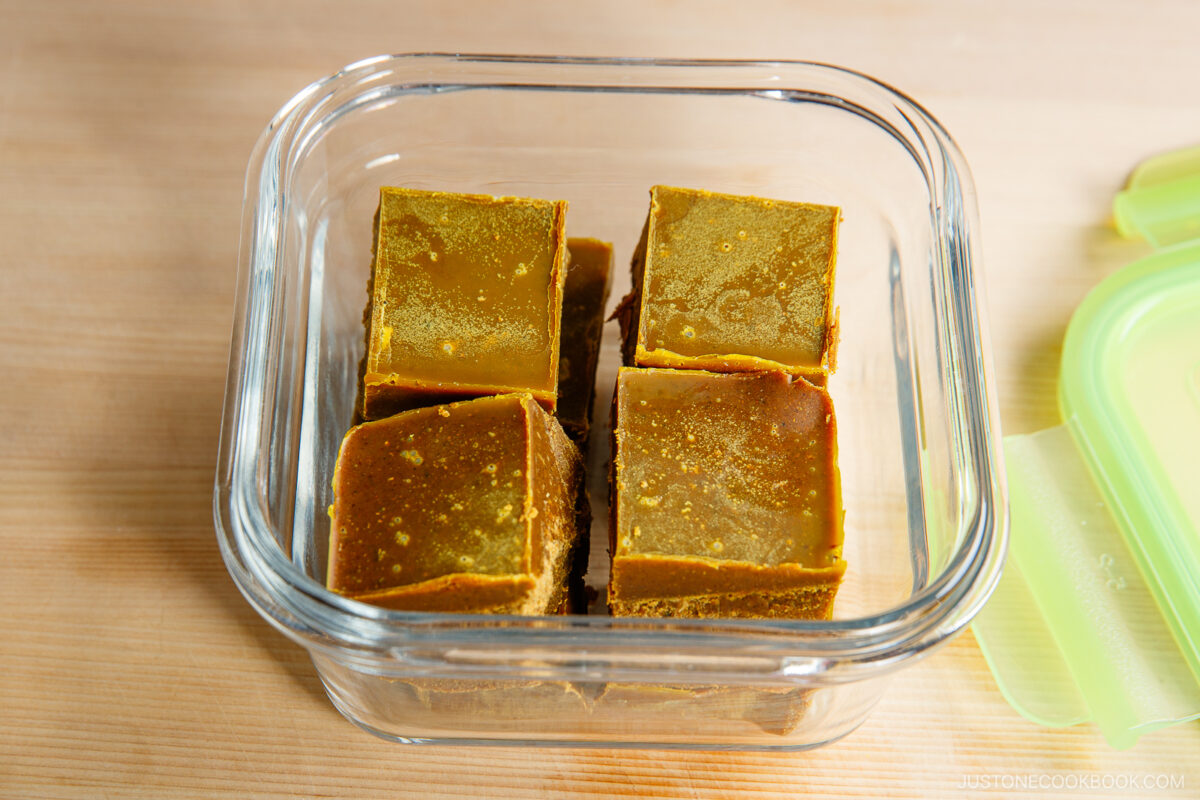
Nami’s Recipe Tips
- Brown it patiently. A deep color means richer, nutty, caramel notes in your curry. Keep the heat moderate and give it the full 20–25 minutes.
- Stir constantly. Roux can scorch in seconds. Use a wooden spoon to start and switch to a whisk if the butter starts to separate.
- Add cayenne sparingly. The heat will intensify as the cubes dissolve and simmer, so start with less and adjust to taste.
- Season at the end. This roux is salt-free. When you cook your Japanese curry, taste the sauce after you mix in the roux and add salt (about 2–4 teaspoons per full block) to taste.
Variations and Customizations
- Dairy-free: Swap in vegan butter.
- Gluten-free: Use a cup-for-cup gluten-free flour blend.
- Extra depth: Sauté minced garlic, ginger, or onion before adding the flour.
- Thicker sauce: Increase butter and flour in equal amounts for a heartier cube.

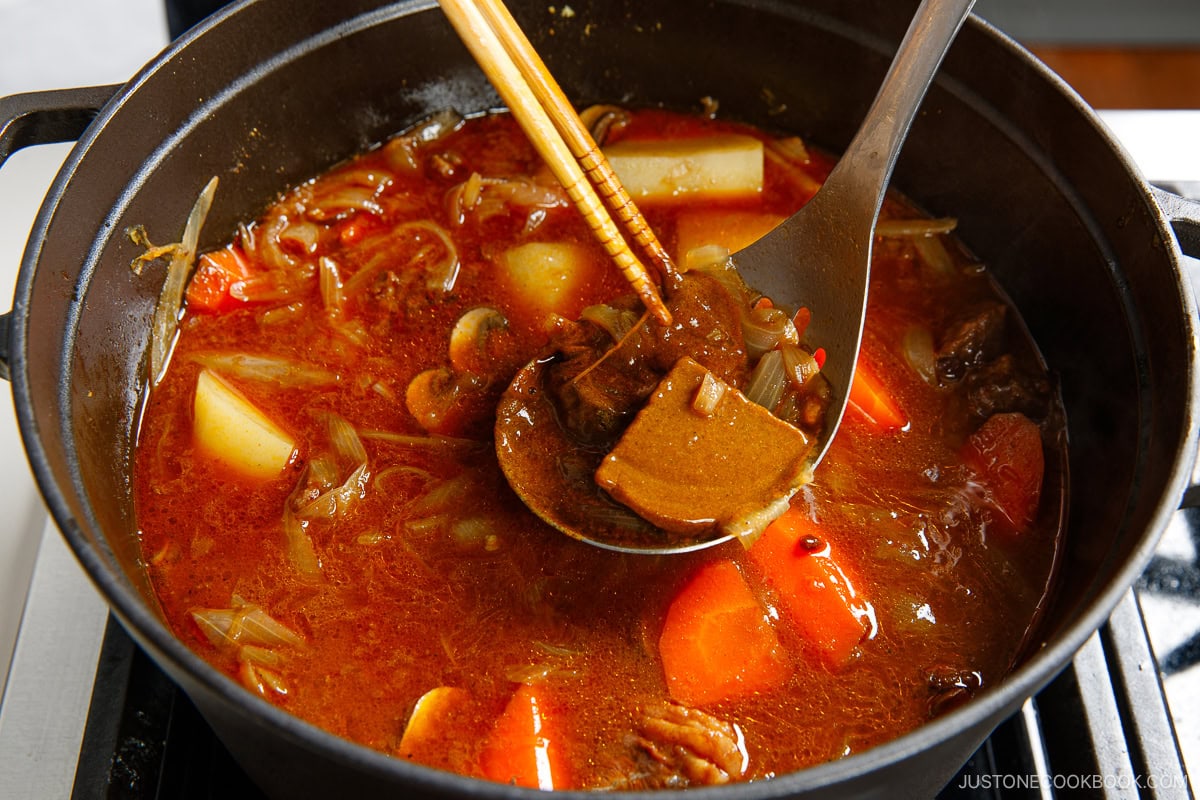
How to Use Japanese Curry Roux in Your Recipe
- How much to use: I find that 6–7 cubes per 4 cups (1 liter) of broth/water is about right. This is equivalent to one box of store-bought curry roux that calls for the same amount of liquid.
- Add to your curry pot: Dissolve the roux, 1 or 2 cubes at a time, in a ladleful of hot broth before releasing it to the pot. If the homemade roux hasn’t solidified yet, you can add it directly to the broth.
- Thicken: Simmer over low heat for 5–10 minutes. If it doesn’t thicken, add more roux. It’s possible that the veggies in your recipe released extra moisture, so please adjust based on the ingredients you’re cooking.
- Adjust the seasoning: Taste the curry after the roux is fully dissolved and incorporated, preferably after 3–5 minutes of simmering. Add the salt or spice to your liking. This homemade roux recipe does not contain any salt.
What to Make with Japanese Curry Roux
With the homemade curry roux, you can cook a myriad of Japanese curry recipes anytime:
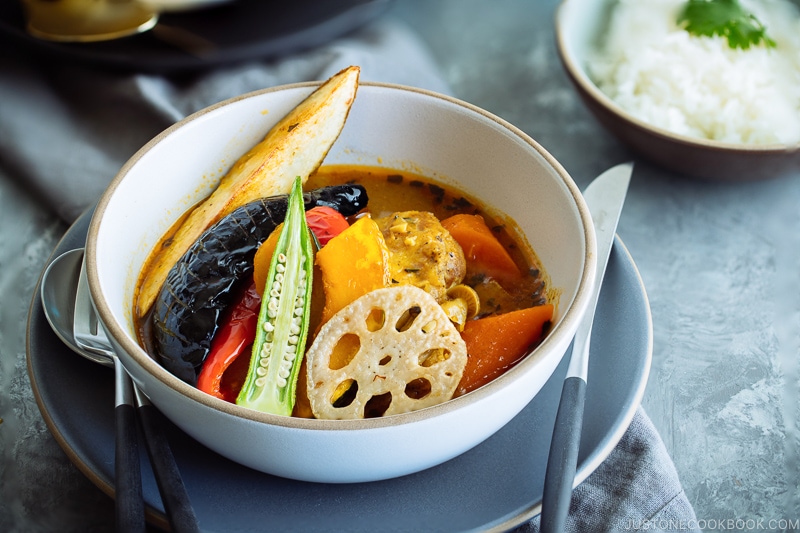
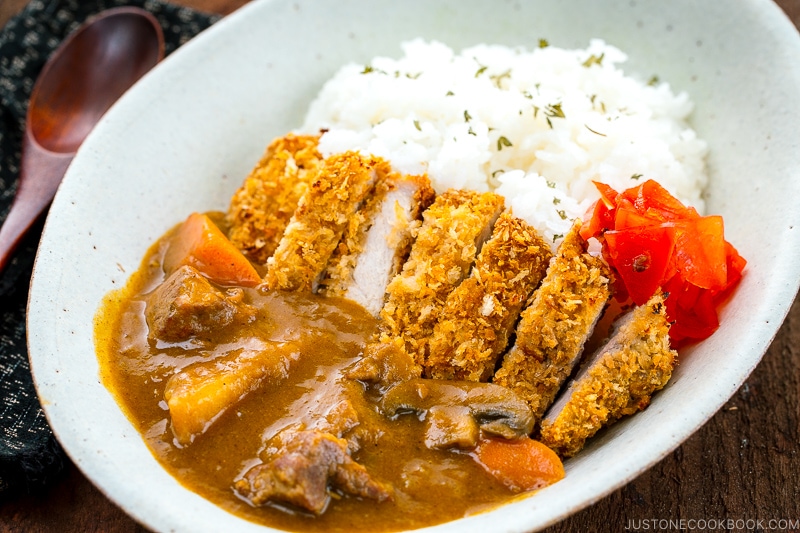
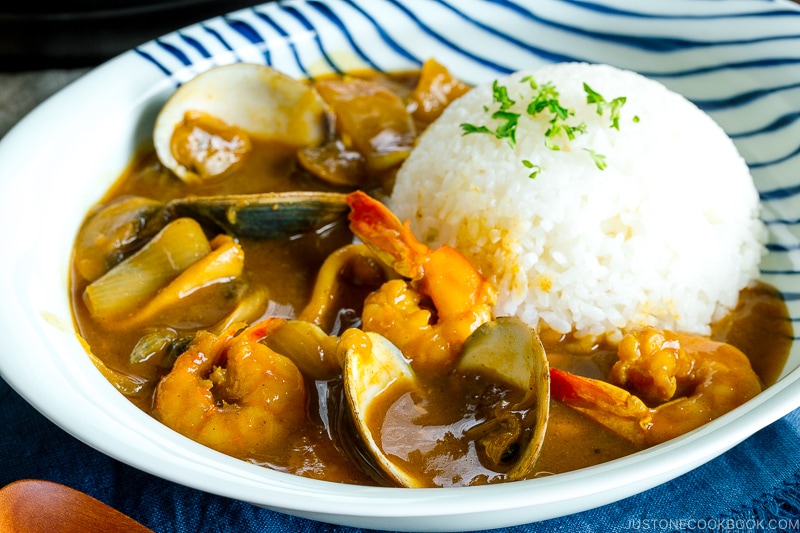
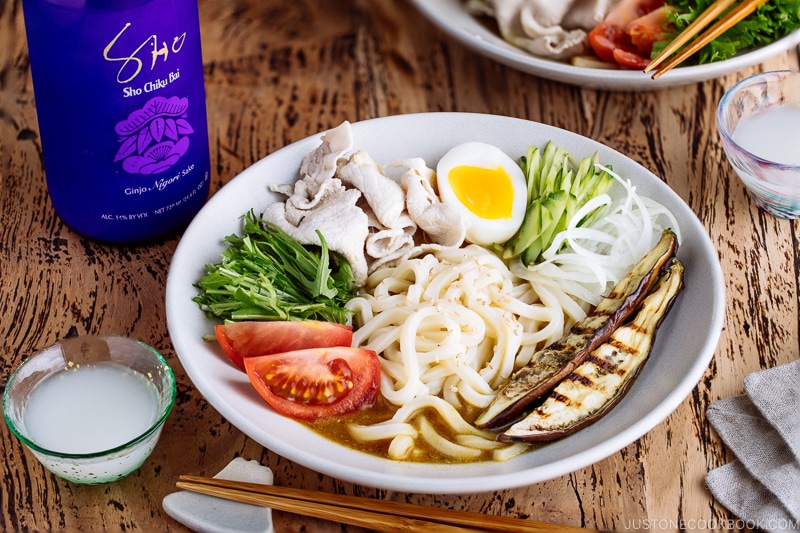
Storage Tips
To store: Keep cubes in the fridge for up to 1 month or freeze for 3–4 months.
Frequently Asked Questions
Too little roux, excess liquid, or watery vegetables can keep it runny. Typical veggies include carrots, potatoes, and onions. Stir in another cube and simmer until the sauce coats the back of a spoon
Six to seven homemade cubes equal one store-bought box designed for 4 cups (1 liter) of broth.
How to Make Japanese Curry Roux
Ingredients
- 3.5 oz unsalted butter (7 Tbsp)
- 3.5 oz all-purpose flour (plain flour) (about ¾ cup; please weigh your flour; click the Metric button for weights; or learn how to measure flour with a measuring cup; use GF flour or rice flour for gluten-free)
- 4 Tbsp Japanese curry powder (I recommend S&B Curry Powder; available on Amazon or make from scratch with my recipe here)
- 1 Tbsp garam masala (see Notes)
- ½ tsp cayenne pepper (optional)
Instructions
- Before You Start: I highly encourage you to weigh your flour and butter using a kitchen scale. For weights, click the Metric button above. If you don't have a scale, here's how to measure flour with a measuring cup: Fluff the flour with a spoon, sprinkle it into the measuring cup, and level it off. Otherwise, you may scoop more than you need.
- Gather all the ingredients.

To Make a Brown Roux
- In a small saucepan, melt 3.5 oz unsalted butter over medium-low heat (you can also add cubed butter and start with medium heat, so it melts faster).
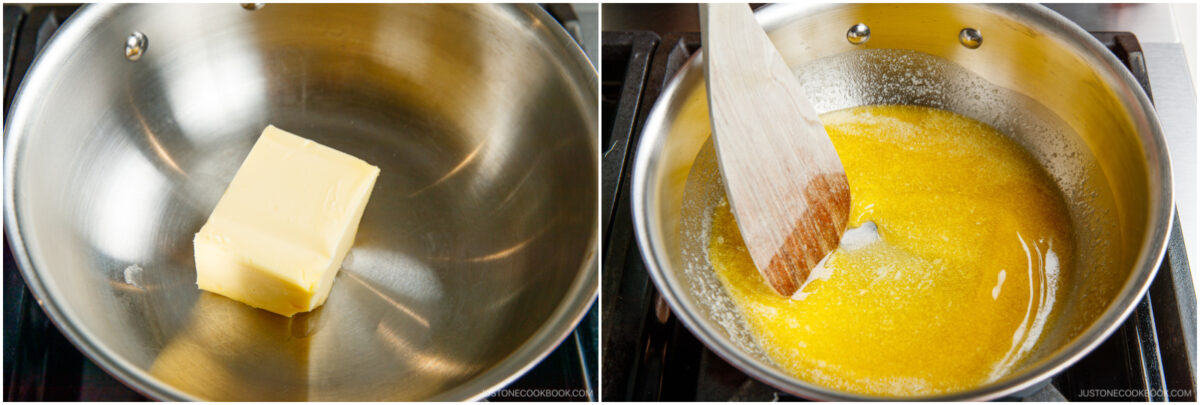
- When the butter is completely melted, add 3.5 oz all-purpose flour (plain flour). With a blunt-end wooden spatula, stir to combine the butter and flour.
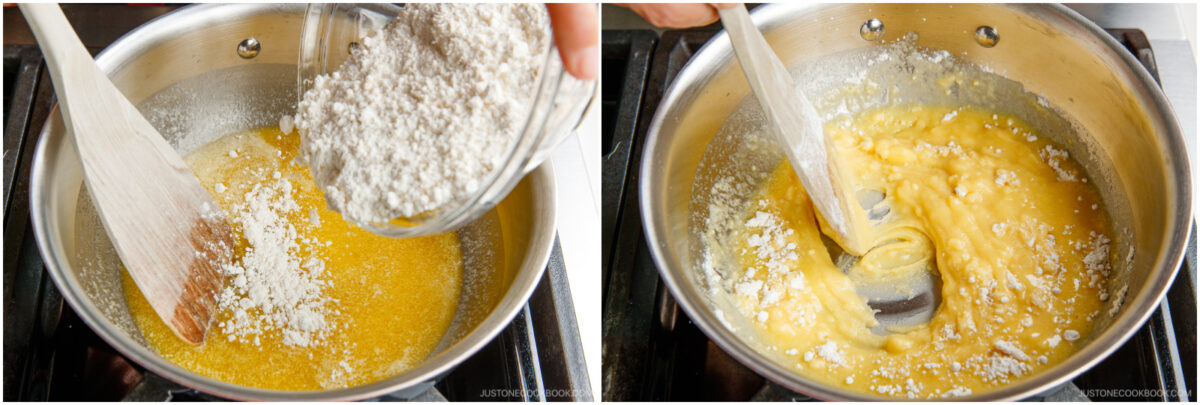
- Soon, the butter and flour will fuse and swell. For the next 20–25 minutes, control the stove's heat to around medium-low heat, and stir constantly because the roux burns easily. Nami's Tip: If the roux starts separating, switch to a whisk and mix vigorously.
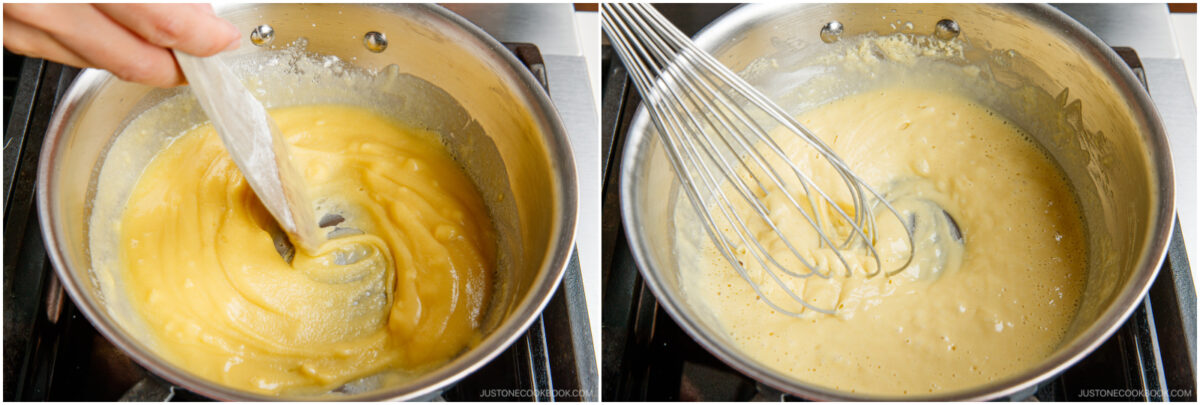
- The roux will turn golden brown quickly toward the end. See the "brown roux" color in the next step. Nami's Tip: Cooking the flour in butter until golden removes its raw, starchy taste and adds a warm, toasty flavor that makes your curry richer and smoother.
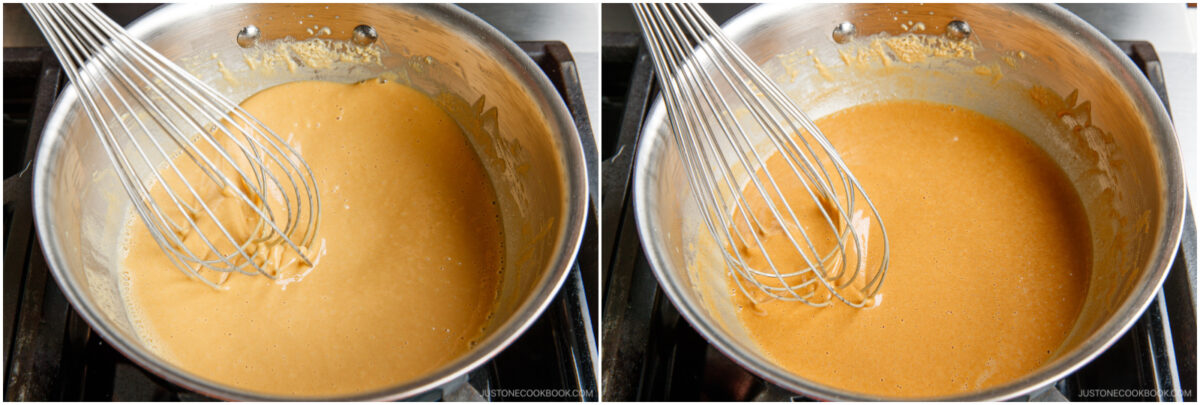
To Make the Curry Roux
- Add 4 Tbsp Japanese curry powder, 1 Tbsp garam masala, and ½ tsp cayenne pepper (optional) to the roux. Tip: If you can‘t find garam masala, you can add more curry powder or individual garam masala spices in its place.

- Cook and stir for 30 seconds and remove from the heat. You can use the roux immediately (see the instructions below) or mold it into a block.
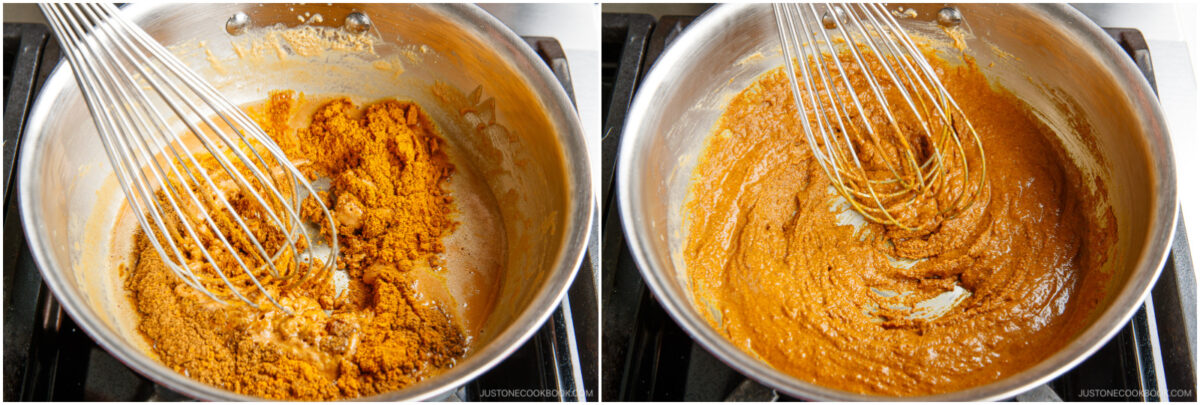
To Mold into a Block (overnight)
- Transfer the roux to a glass or metal container lined with parchment paper. Let it cool completely on the kitchen counter, then refrigerate to solidify overnight.
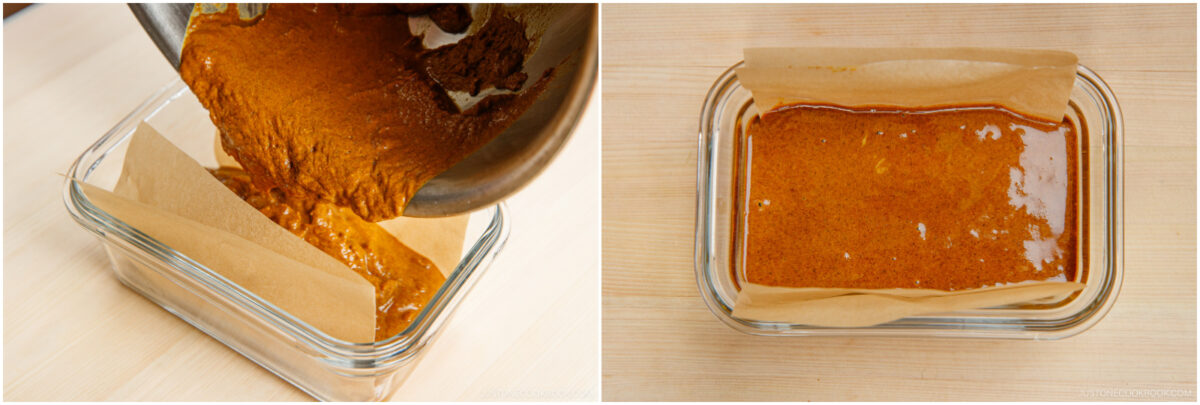
- The next day, take out the curry block from the container. If the curry block gets stuck to the container, release it with a butter knife or an offset spatula.
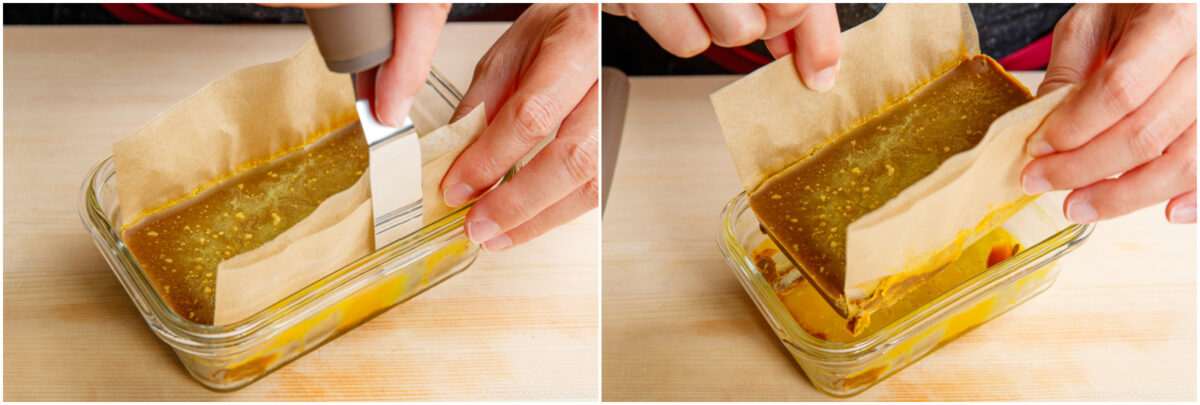
- With a sharp knife, cut the block into 8 cubes, about 1 x 1 inch (2.5 x 2.5 cm) each. Transfer the curry roux squares to a glass container.
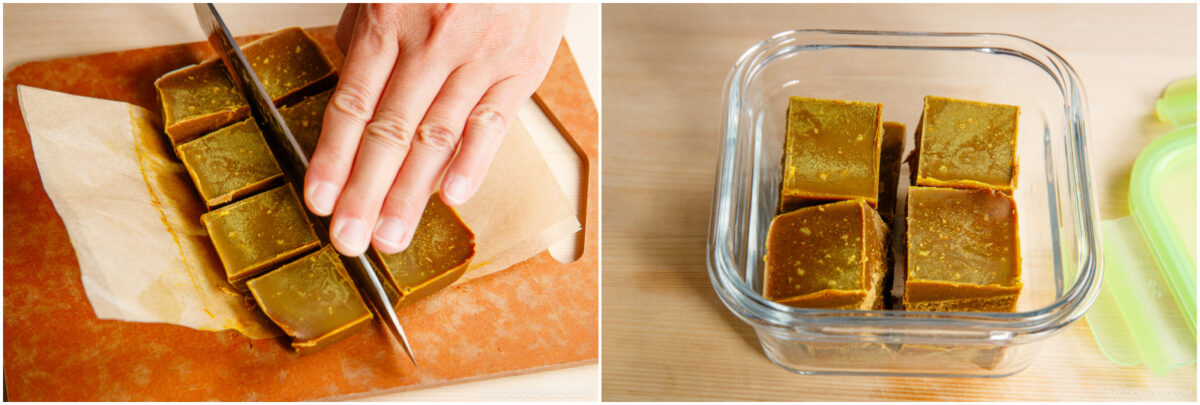
To Store
- Store in the refrigerator for 1 month or in the freezer for 3–4 months. Use them soon for the best flavor and aroma.
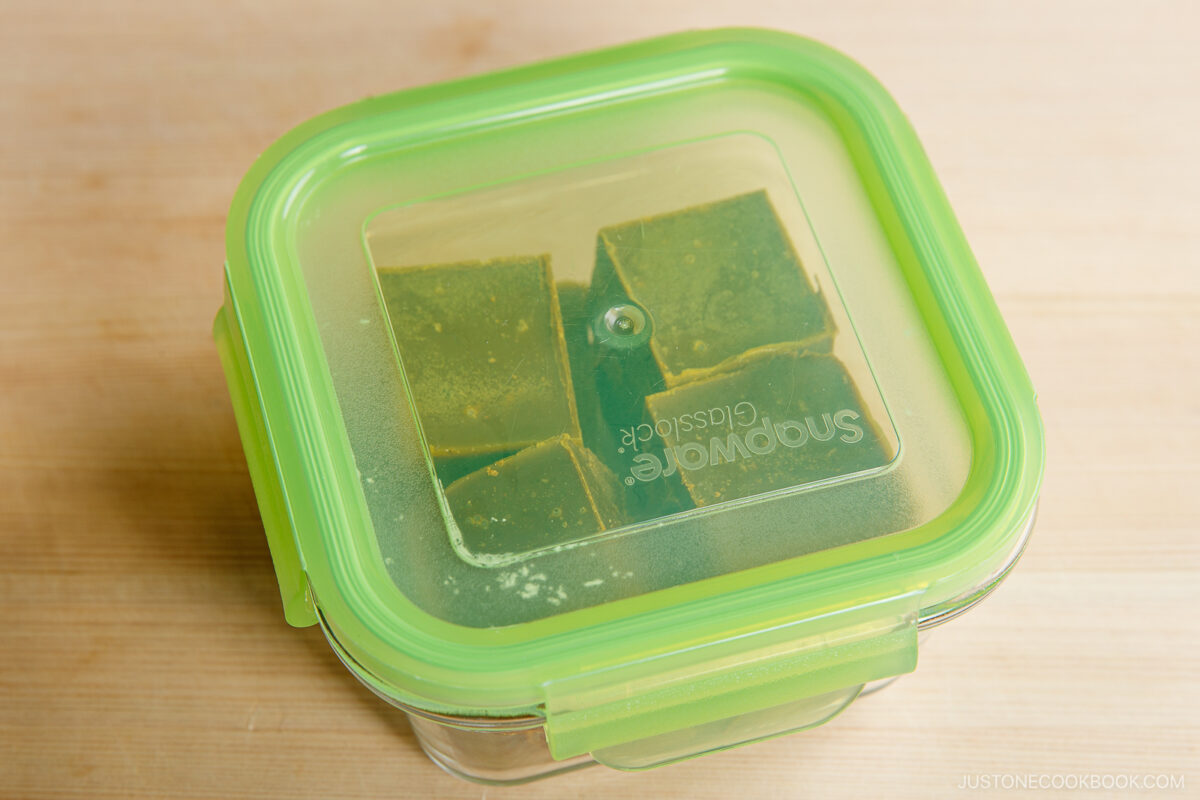
To Use in a Curry Recipe
- Very important! Please season your final dish with more salt, as the homemade roux is unsalted. I usually add 2–4 tsp salt per serving (one block) to the broth of my curry sauce recipe. Store-bought curry roux is quite salty, so you may want to add more salt to achieve a similar taste.
- Add the roux cubes or curry roux mixture (before it solidifies) to the broth of your curry recipe. Follow the recipe instructions on when to add it. Try it in recipes like my Chicken Curry, Instant Pot Curry, Vegetarian Curry, Beef Curry, Keema Curry, and Curry Udon.
- How much roux should we use? Roughly 6–7 cubes of this recipe are equivalent to one box of store-bought curry roux (that requires 4 cups or 1L of broth/water). Simmer over low heat for 5–10 minutes. Heat will thicken the roux.
- If the curry flavor is lacking or the curry does not thicken, add more roux. When you add meat and/or veggies, they release more moisture to the broth; therefore, you will need to adjust the amount of roux you use according to what you’re cooking.
Notes
- Different garam masala blends can vary significantly in intensity and flavor profile, so adjust the amount to taste!
Nutrition
Did you make this recipe?
Tag @justonecookbook on Instagram so we can see your delicious creation!
Editor’s Note: This post was originally published on March 18, 2013. A video and new images were added in August 2018. The recipe was revised and updated with fresh images and content on October 20, 2021. It was republished again with more helpful content on August 28, 2025.



